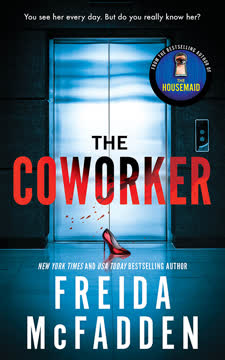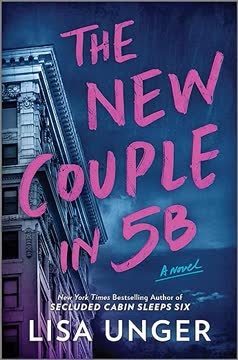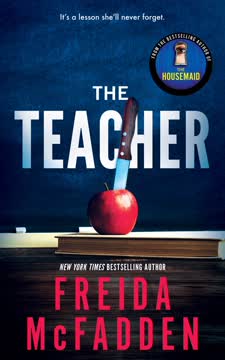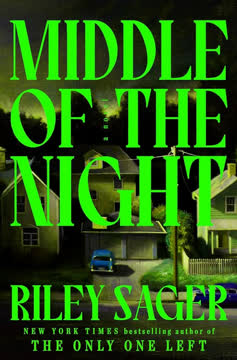Plot Summary
Arrival in Maine Shadows
Sadie and Will Foust, along with their two sons, Otto and Tate, relocate from bustling Chicago to a remote island off the coast of Maine, inheriting a decrepit old house and guardianship of Will's troubled teenage niece, Imogen, after the suicide of Will's sister, Alice. The move is meant to be a fresh start after marital infidelity and trauma in Chicago, but the house's oppressive atmosphere and Imogen's hostility immediately unsettle Sadie. The isolation of the island, the coldness of the house, and the family's unresolved issues create a sense of foreboding. Sadie's unease is heightened by the sense that something is off—not just with the house, but with her own grasp on reality and the dynamics within her family.
The Murder Next Door
Shortly after the Fousts settle in, their neighbor, Morgan Baines, is found brutally murdered in her home. The small, insular community is shaken, and suspicion quickly falls on the new arrivals. Sadie, already on edge, becomes obsessed with the crime, feeling both threatened and implicated. The murder investigation, led by the awkward but persistent Officer Berg, brings scrutiny to the Fousts, especially as Sadie's alibi is questioned and her memory of the night is unreliable. The murder's brutality and the lack of forced entry suggest the killer was someone Morgan knew, and Sadie's anxiety grows as she realizes how little she knows about her neighbors—or her own family.
Imogen's Dark Presence
Imogen, Will's sixteen-year-old niece, is a brooding, antagonistic presence in the house. She resents the Fousts' intrusion into her life and home, lashing out with threats and disturbing behavior. Sadie tries to be understanding, knowing Imogen is grieving her mother's suicide, but Imogen's anger is relentless. She leaves menacing messages, isolates herself, and seems to know more about the family's secrets than she lets on. Her relationship with Sadie is especially fraught, and Sadie begins to fear Imogen's capacity for violence, especially as evidence mounts that someone in the house may be connected to Morgan's murder.
Ghosts of Chicago
The Fousts' move to Maine is haunted by unresolved trauma from Chicago. Sadie's career as a doctor was derailed by a patient's death and a subsequent breakdown, while Otto, their teenage son, was expelled for bringing a knife to school after being bullied. Will's infidelity lingers as a wound in the marriage, and Sadie's trust is fragile. The family's attempt at a new beginning is undermined by these ghosts, and Sadie's sense of reality becomes increasingly unstable as she questions her own memory, her children's safety, and Will's loyalty.
The Threatening Messages
Morgan Baines had received anonymous, threatening notes before her death: "You know nothing. Tell anyone and die. I'm watching you." As the investigation unfolds, Sadie discovers a bloody washcloth and a missing knife in her own home, and Morgan's necklace appears inexplicably on her stairs. The evidence seems to implicate someone in the Foust household, but Sadie's memory is unreliable, and she begins to fear she herself may be responsible. The paranoia is compounded by the island's isolation and the community's suspicion, as well as Sadie's growing sense that she is being watched and manipulated.
Camille's Seduction
Interspersed with Sadie's narrative are chapters from Camille, a seductive, volatile woman who claims to have had an affair with Will in Chicago. Camille's voice is intimate, obsessive, and increasingly unhinged. She describes stalking Will, manipulating situations, and feeling both possessive and vengeful toward Sadie. Camille's presence in the narrative is destabilizing, blurring the lines between reality and delusion, and hinting at a deeper psychological fracture within Sadie's mind.
Mouse and the Past
Another narrative thread emerges: Mouse, a six-year-old girl living with her father and a cruel stepmother, "Fake Mom." Mouse's chapters are innocent yet chilling, describing emotional and physical abuse, the loss of her beloved pet, and her strategies for survival. Mouse's story is revealed to be a repressed memory from Sadie's own childhood, a key to understanding her dissociative identity disorder and the origins of her psychological fragmentation.
The Unraveling Marriage
As the investigation intensifies, Sadie and Will's marriage unravels. Sadie discovers Will's ongoing deceptions, hidden money, and his manipulative control over her medication and mental health. Will gaslights Sadie, undermining her sense of reality and blaming her for the family's troubles. The tension escalates as Sadie realizes Will may be more dangerous than she ever imagined, and that he is capable of violence and betrayal far beyond infidelity.
The Missing Knife
The discovery of the missing boning knife—matching the murder weapon—buried in the Fousts' backyard, and a blood-soaked washcloth in the laundry, brings the investigation to a crisis. Sadie's attempts to turn over the evidence are thwarted as the items disappear, and her own alibi is undermined by Will's shifting story. The police begin to suspect Sadie, especially as her dissociative episodes and memory lapses become more pronounced. The sense of danger within the house grows, and Sadie fears for her own life and her children's safety.
The Memorial and the Ex
At Morgan's memorial service, Sadie observes a tense confrontation between Morgan's husband, Jeffrey, and his ex-wife, Courtney. The community's gossip reveals that Morgan was Jeffrey's mistress before their marriage, and that Courtney had tried to abduct their daughter. Sadie's investigation into Courtney's background uncovers legal battles and deep-seated animosity, but the true connection between Morgan and Sadie's own past remains hidden until a photograph reveals that Morgan was the younger sister of Erin—Will's first fiancée, who died under suspicious circumstances years earlier.
Dissolving Reality
Sadie's grip on reality dissolves as her dissociative identity disorder intensifies. She experiences blackouts, lost time, and the emergence of alternate personalities—Camille, the seductive avenger, and Mouse, the traumatized child. Therapy sessions reveal that Sadie's mind has splintered to protect her from childhood abuse and recent trauma. The narrative becomes increasingly fragmented, with Sadie, Camille, and Mouse vying for control, and the truth about Morgan's murder slipping further out of reach.
The Truth About Alice
A confrontation at Alice's grave leads Imogen to confess to Sadie that she helped her mother die, pulling the stool from beneath Alice's feet at her mother's desperate request. The revelation reframes Alice's death as assisted suicide rather than murder, and exposes the depth of Imogen's trauma and guilt. Imogen's relationship with Sadie shifts from hostility to a fragile alliance, as both women recognize the ways they have been manipulated and harmed by those they trusted.
The Dissociation Deepens
Therapy and police interrogation reveal the extent of Sadie's dissociative identity disorder. Camille and Mouse are not external threats, but parts of Sadie herself—Camille embodying her rage and sexuality, Mouse her childhood vulnerability. Will has exploited Sadie's condition, gaslighting her, controlling her medication, and manipulating her into doubting her own sanity. The realization that Will may have used her alters to commit violence on his behalf is both liberating and terrifying for Sadie.
Will's Manipulations
Will is unmasked as the true villain: a charming, narcissistic manipulator who has orchestrated violence and murder to protect himself and his secrets. He killed Erin, his first fiancée, and manipulated Sadie's alter Camille into killing Morgan, who threatened to expose his past. Will's control over Sadie is total—he has hidden evidence, sabotaged her mental health, and planned to kill her and make it look like suicide. The final confrontation is set as Sadie realizes the full extent of Will's evil.
The Final Confrontation
In a harrowing climax, Will attempts to murder Sadie, staging her death as a suicide. Drugged and weakened, Sadie fights back, aided by Imogen, who intervenes with a fireplace poker. In the chaos, Sadie stabs Will in self-defense, killing him. The truth of Will's crimes is revealed through a recording Imogen made of his confession, exonerating Sadie and exposing Will as the architect of the violence that has haunted their lives.
Aftermath and Healing
A year later, Sadie and her children, along with Imogen, have relocated to California, forging a new life far from the darkness of Maine. Through therapy and mutual support, they begin to heal from the trauma inflicted by Will and the legacy of abuse and manipulation. Sadie works to integrate her fractured self, finding strength in her survival and hope for the future. The family's journey is one of resilience, forgiveness, and the possibility of transformation, even after the deepest wounds.
Characters
Sadie Foust
Sadie is a complex, deeply traumatized woman struggling with dissociative identity disorder, the result of childhood abuse and recent psychological shocks. As the main narrator, her perspective is unreliable, colored by blackouts, memory lapses, and the emergence of alternate personalities. Sadie is both a victim and, at times, an unwitting perpetrator, manipulated by her husband and haunted by guilt over her family's unraveling. Her journey is one of self-discovery, as she confronts the truth about her past, her mental illness, and her capacity for both vulnerability and strength. Her relationships—with Will, her children, and Imogen—are fraught with mistrust, longing, and the desperate need for safety and love.
Will Foust
Will is Sadie's husband, a seemingly devoted father and partner whose affable exterior masks a calculating, narcissistic core. He is a master of gaslighting, exploiting Sadie's mental illness to control and isolate her. Will's history of infidelity, emotional abuse, and ultimately murder is revealed gradually, as he is unmasked as the true villain of the story. He orchestrates violence to protect himself, including the deaths of his first fiancée, Erin, and Morgan Baines, and attempts to frame Sadie for murder. Will's psychological profile is that of a classic sociopath—charming, remorseless, and ultimately deadly.
Imogen
Imogen is Will's sixteen-year-old niece, left in the Fousts' care after her mother's suicide. She is angry, rebellious, and deeply wounded, lashing out at Sadie and the world. Imogen's hostility masks profound grief and guilt, especially after she confesses to assisting her mother's death. Over time, Imogen's relationship with Sadie shifts from antagonism to solidarity, as both women recognize their shared victimization and the need to protect each other. Imogen's development is a journey from rage and isolation to tentative trust and healing.
Otto Foust
Otto, Sadie and Will's teenage son, is introverted, artistic, and deeply affected by bullying and family upheaval. His expulsion from school for bringing a knife is a symptom of his desperation and alienation. Otto's relationship with Sadie is strained by her mental illness and his own trauma, but he remains a figure of empathy and resilience. His psychological struggles mirror those of his mother, and his journey is one of seeking belonging and self-acceptance.
Tate Foust
Tate, the youngest Foust, is a bright, loving boy whose innocence is a counterpoint to the darkness surrounding the family. His confusion and distress at the family's turmoil highlight the impact of trauma on children, but his resilience and capacity for joy offer a glimmer of hope for the future.
Camille
Camille is one of Sadie's alternate personalities, embodying her repressed rage, sexuality, and capacity for violence. Camille's voice is seductive, impulsive, and vengeful, acting out desires and actions Sadie cannot consciously acknowledge. Camille is both a protector and a threat, manipulated by Will to commit violence on his behalf. Her emergence is a symptom of Sadie's psychological fracture and a key to understanding the novel's central mystery.
Mouse
Mouse is the six-year-old alter within Sadie, representing her childhood innocence and the pain of abuse by her stepmother. Mouse's chapters are poignant and disturbing, revealing the origins of Sadie's dissociation and her strategies for survival. Mouse is a symbol of vulnerability and the enduring impact of childhood trauma.
Officer Berg
Officer Berg is the island's police officer, awkward but persistent in his investigation of Morgan's murder. He is both a source of suspicion and, ultimately, a reluctant ally, as he uncovers the truth about the Fousts and the web of secrets surrounding them. Berg's own limitations and biases complicate the investigation, but his pursuit of justice is genuine.
Morgan Baines
Morgan is the murdered neighbor whose death sets the plot in motion. She is revealed to be the younger sister of Erin, Will's first fiancée, and the recipient of threatening notes before her death. Morgan's relationships—with her husband, stepdaughter, and the Fousts—are fraught with secrets and betrayals. Her murder is the catalyst for the unraveling of the Foust family and the exposure of Will's crimes.
Erin Sabine
Erin is Will's first fiancée, whose death years earlier was ruled an accident but is ultimately revealed to be murder at Will's hands. Erin's memory haunts both Will and Sadie, and her connection to Morgan is the key to understanding the novel's central mystery. Erin's death is the original sin that sets the cycle of violence and manipulation in motion.
Plot Devices
Unreliable Narration and Dissociation
The novel's structure relies on Sadie's unreliable narration, shaped by her dissociative identity disorder. The emergence of alternate personalities—Camille and Mouse—creates a fractured, multi-voiced narrative that blurs the line between reality and delusion. This device keeps the reader off-balance, mirroring Sadie's own confusion and vulnerability, and allows for dramatic reveals as the true nature of events and characters is gradually uncovered. The use of multiple timelines, blackouts, and lost time heightens suspense and deepens the psychological complexity of the story.
Red Herrings and Misdirection
Kubica employs classic thriller misdirection, casting suspicion on Imogen, Otto, and even Sadie herself, as evidence and memory lapses point in multiple directions. The threatening notes, missing evidence, and shifting alibis keep the reader guessing, while the true villain—Will—is hidden in plain sight. The layering of secrets, lies, and partial truths creates a labyrinthine plot that rewards close reading and psychological insight.
Interwoven Narratives and Flashbacks
The novel intersperses Sadie's present-day narrative with chapters from Camille and Mouse, as well as flashbacks to Chicago and Sadie's childhood. These interwoven narratives gradually reveal the origins of Sadie's trauma, the extent of Will's manipulation, and the connections between past and present. The use of therapy sessions, police interrogations, and recovered memories serves as both exposition and psychological exploration.
Foreshadowing and Symbolism
Kubica uses recurring motifs—mirrors, knives, dolls, threatening messages, and the oppressive house itself—to foreshadow the novel's revelations. The motif of the "other Mrs." operates on multiple levels: the literal other women in Will's life, the alternate personalities within Sadie, and the idea of women being pitted against each other by male violence and manipulation. The house, with its locked rooms and hidden evidence, symbolizes the secrets and traumas buried within the family and Sadie's mind.
Analysis
The Other Mrs. is a masterful exploration of the ways trauma fractures identity and how abusers exploit vulnerability for their own ends. Through Sadie's dissociative identity disorder, Kubica dramatizes the struggle to reclaim agency and truth in the face of gaslighting, violence, and self-doubt. The novel interrogates the dangers of charismatic men who weaponize love and trust, and the societal tendency to blame women for their own victimization. By ultimately empowering Sadie and her children to break free from Will's control and begin healing, the book offers a message of hope: that even after profound betrayal and psychological damage, it is possible to survive, integrate the past, and build a new, authentic self. The story's twists and layered perspectives challenge the reader to question appearances, trust their instincts, and recognize the strength required to confront both external threats and the darkness within.
Last updated:
FAQ
Synopsis & Basic Details
What is The Other Mrs. about?
- A Family's Troubled Relocation: The Other Mrs. follows Sadie Foust and her family as they move from Chicago to a remote Maine island, inheriting a dilapidated house and guardianship of Will's hostile teenage niece, Imogen, after Alice's suicide. This "fresh start" is quickly overshadowed by the murder of their neighbor, Morgan Baines, plunging Sadie into a web of local suspicion and unsettling family secrets.
- Unraveling Psychological Mystery: As Sadie grapples with the murder investigation, her own unreliable memory, and Imogen's dark presence, the narrative delves into her fractured psyche. Readers are introduced to alternate personalities—the seductive Camille and the traumatized child Mouse—hinting at a deeper psychological struggle that blurs the lines of truth and delusion.
- Secrets and Suspicions: The story is a tense psychological thriller exploring themes of trauma, manipulation, and the hidden lives within a seemingly ordinary family. It forces Sadie to confront not only the mystery of Morgan's death but also the buried truths of her own past and the unsettling reality of those closest to her.
Why should I read The Other Mrs.?
- Masterful Psychological Suspense: Readers seeking a deeply immersive psychological thriller will be captivated by Mary Kubica's expert use of an unreliable narrator. The novel constantly challenges perceptions, making you question every character's motives and every detail, leading to a truly shocking conclusion.
- Complex Character Exploration: Beyond the thrilling plot, The Other Mrs. offers a profound exploration of trauma, identity, and resilience. Sadie's journey through dissociative identity disorder (DID) is handled with nuance, providing a compelling look at how the human mind copes with unbearable pain and manipulation.
- Twisty, Unpredictable Plot: If you love novels with unexpected twists and turns, this book delivers. The layered narratives, red herrings, and gradual reveals keep the tension high, ensuring that just when you think you've figured it out, another layer of deception is peeled back. It's a perfect read for fans of domestic thrillers and intricate mysteries.
What is the background of The Other Mrs.?
- Setting the Stage: Isolated Maine Island: The novel leverages the geographical and cultural isolation of a remote Maine island. This setting intensifies the sense of claustrophobia and paranoia, as the small, insular community becomes a pressure cooker for suspicion and gossip, highlighting the vulnerability of newcomers like the Fousts.
- Contemporary Mental Health Focus: A significant background element is the exploration of dissociative identity disorder (DID), a complex mental health condition. The author's note explicitly states a personal connection to mental illness, aiming to raise awareness and emphasize the importance of proper care and treatment, grounding the psychological thriller in a relevant social context.
- Echoes of Past Trauma: The narrative is deeply rooted in the characters' past traumas, particularly Sadie's childhood abuse and Will's history of violence. These past events, originating in Chicago and other locations, are not just backstory but active forces shaping the present-day plot, demonstrating how unresolved issues can resurface with devastating consequences.
What are the most memorable quotes in The Other Mrs.?
- "She tried to run, but she can't escape the other Mrs.": This opening line, also the book's tagline, is profoundly memorable for its multi-layered foreshadowing. It hints at Sadie's internal struggle with her alters (Camille and Mouse), the literal "other Mrs." in Will's life (Morgan, Erin), and the inescapable nature of her past trauma and identity.
- "You're too smart for your own good, Sadie. If only you'd have let it be, this wouldn't be happening. But I can't have you go around telling people what I did. I'm sure you understand. And since you can't keep your own mouth closed, it's up to me to shut you up for good.": Uttered by Will during the climax, this chilling confession reveals his true sociopathic nature and the extent of his manipulation. It encapsulates his gaslighting, his motive for murder, and his ultimate intent to silence Sadie, making it a pivotal moment in The Other Mrs. ending explained.
- "If time can turn something so undesired into something so loved, the same can happen to all of us. The same can happen to me. It's happening already.": This reflective quote from Sadie in the "One Year Later" chapter offers a powerful message of hope and resilience. It symbolizes her journey of healing and integration, likening her transformation from trauma to the beach glass repurposed from discarded trash, highlighting the central themes in The Other Mrs. of finding beauty and strength after profound suffering.
What writing style, narrative choices, and literary techniques does Mary Kubica use?
- Fragmented, Multi-Perspective Narrative: Kubica employs a non-linear, multi-perspective narrative, primarily shifting between Sadie's first-person present, Camille's first-person past, and Mouse's childlike perspective. This fragmented structure is crucial for depicting Sadie's dissociative identity disorder, creating an unreliable narrative that keeps readers disoriented and constantly questioning reality, enhancing the psychological thriller aspect.
- Sensory and Emotional Immersion: The author excels at immersing the reader in Sadie's internal world through vivid sensory details and raw emotional descriptions. The oppressive atmosphere of the Maine house, the biting cold, the smell of damp earth, and Sadie's physical sensations of panic, nausea, and disorientation are consistently used to reflect her psychological state and heighten the tension.
- Subtle Foreshadowing and Thematic Echoes: Kubica masterfully weaves in subtle clues and thematic repetitions that gain significance upon re-reading. Recurring motifs like the creaking stairs, the specific details of the dollhouse, and even seemingly throwaway lines about character habits (e.g., Will's "magnanimous" touch) serve to foreshadow major plot revelations and reinforce the underlying themes of manipulation and hidden truths.
Hidden Details & Subtle Connections
What are some minor details that add significant meaning?
- The Creaking Stairs as a Warning System: Mouse's chapters detail her reliance on the house's "groaning" stairs, especially the loudest "last step," as a warning system for her stepmother's approach. This seemingly minor architectural detail later becomes a crucial plot point, as Imogen uses the same knowledge to navigate the house silently, and it subtly foreshadows the idea of hidden dangers within the home.
- Tate's "Statue Game" and Sadie's Alters: Tate's repeated insistence on playing the "statue game" initially seems like childish whimsy, but it directly connects to Sadie's therapy sessions where her child alter, Mouse, plays the same game. This detail subtly reveals the presence of Mouse within Sadie long before it's explicitly stated, highlighting the deep-seated nature of Sadie's dissociation and the way her alters manifest in her children's lives.
- The Dollhouse as a Microcosm of Trauma: The dollhouse in the attic, initially seen as a charming heirloom, becomes a symbolic representation of the Foust family's internal dynamics and hidden traumas. Sadie's initial arrangement of the dolls (family asleep) contrasts sharply with how she later finds them (girl on floor, father missing, knife at mother's feet), mirroring the unraveling of her own family and foreshadowing the violence and secrets within. This is a key piece of The Other Mrs. symbolism.
What are some subtle foreshadowing and callbacks?
- Sadie's Acrophobia and Will's Balcony Habit: Sadie's intense fear of heights, particularly her refusal to go on their Chicago condo's sixth-floor balcony, is a subtle but significant detail. Later, Otto describes "Mom" (Camille) sitting on the fire escape, a high place, directly contradicting Sadie's known phobia. This foreshadows the existence of an alter who doesn't share Sadie's fears and hints at the fragmented nature of her identity, a crucial element in Sadie Foust's psychological profile.
- The "Die" Message and Otto's Bullying: The word "Die" traced in frost on Sadie's car window is initially attributed to Imogen. However, it later echoes the bullying Otto endured in Chicago ("Die, faggot, die"). This callback subtly links the seemingly disparate threats and suggests a deeper, more complex source of violence and trauma within the family, hinting at the interconnectedness of their past and present struggles.
- Will's "Magnanimous" Touch and Hidden Cruelty: Sadie frequently describes Will's touch as "magnanimous" or "intoxicating" early in the novel, even after his affair. This seemingly positive description is subtly undermined by her growing unease and later revealed as a manipulative facade. The callback to his "persuasive hands" and "those eyes" during the affair chapters foreshadows his ultimate capacity for physical violence and control, revealing the true Will Foust psychological profile.
What are some unexpected character connections?
- Sadie's Roommate and Camille's Traits: Sadie briefly mentions a manipulative, kleptomaniac former roommate who was "combative" and "mean," and who Sadie suspected made a copy of her key. This seemingly throwaway detail unexpectedly mirrors Camille's behavior—her manipulative nature, her ability to enter homes, and her aggressive tendencies—subtly hinting that Camille's personality might have roots in Sadie's past experiences with this "other woman."
- Officer Berg's Personal Generosity and Professional Bias: Officer Berg's secret financial aid to the Nilssons, motivated by empathy for their struggles, reveals a compassionate side to his character. This unexpected detail contrasts with his professional bias and initial willingness to suspect Sadie, highlighting the complexities of his character and the human element behind the investigation, rather than just a "dogged investigator."
- Jeffrey Baines's Grief and Will's Lack Thereof: Jeffrey Baines, Morgan's husband, initially appears detached at the memorial, leading Sadie to suspect him. However, his later confession of Morgan's fear and his own regret ("I didn't ask enough") reveals genuine grief and vulnerability. This unexpected display of emotion contrasts sharply with Will's calculated lack of remorse for Erin and Morgan, subtly emphasizing Will's sociopathic nature by comparison.
Who are the most significant supporting characters?
- The Nilssons: Unwitting Witnesses and Moral Compass: George and Poppy Nilsson, the elderly neighbors, are crucial not just as witnesses (albeit unreliable ones) but also as a subtle moral compass. Their financial struggles and Officer Berg's anonymous help highlight community dynamics and Berg's character depth. Their "testimony" about Sadie and Morgan's argument, though mistaken, drives a significant part of the early investigation, making them more than just background figures.
- Joyce and Emma: The Clinic's Gatekeepers and Reality Check: Sadie's colleagues at the medical clinic, Joyce and Emma, serve as important external anchors to reality, often challenging Sadie's perceptions of time and her own behavior. Joyce's strictness and Emma's accidental revelations about Sadie's whereabouts during her "blackouts" provide concrete evidence of Sadie's dissociative episodes, pushing the plot forward and deepening the unreliable narrator techniques.
- Courtney Baines: The Misdirected Suspect and Catalyst for Truth: Jeffrey's ex-wife, Courtney, initially appears as a prime suspect due to her volatile history with Morgan and her confession of anger. Her legal battle for child custody and her emotional outburst at the memorial service serve as a powerful red herring, diverting suspicion while simultaneously providing Sadie with crucial information about Morgan's past and the Baines family dynamics, which indirectly leads to the truth about Will.
Psychological, Emotional, & Relational Analysis
What are some unspoken motivations of the characters?
- Will's Need for Absolute Control: Beyond simply escaping his past, Will's unspoken motivation for moving to Maine and isolating Sadie is to gain absolute control over her and her mental state. His manipulation of her medication and his gaslighting are driven by a deep-seated need to maintain power, ensuring she remains dependent and unable to expose his crimes, a core aspect of Will Foust's psychological profile.
- Imogen's Protective Instinct for Alice's Memory: Imogen's initial hostility towards Sadie isn't solely grief; it's also an unspoken, fierce protectiveness of her mother's memory and the secrets surrounding her death. Her anger is a shield, and her later confession to Sadie is a desperate attempt to control the narrative of Alice's life and death, revealing the depth of Imogen's character analysis.
- Sadie's Subconscious Drive for Order and Truth: Sadie's compulsive need to check locks, clean, and organize, even amidst her mental turmoil, is an unspoken motivation to impose order on her chaotic internal and external world. This drive for control, though often undermined by her alters, is a subconscious quest for truth and stability, reflecting her deep-seated desire to understand and heal from her fragmented reality.
What psychological complexities do the characters exhibit?
- Sadie's Dissociative Identity as a Survival Mechanism: Sadie's DID is not merely a plot device but a complex psychological response to profound trauma. Her alters, Camille (rage/protector) and Mouse (childhood trauma/vulnerability), represent fragmented aspects of her psyche that emerged to cope with abuse and unbearable emotional pain. This fragmentation allows her to compartmentalize traumatic memories, but also makes her vulnerable to manipulation, central to Sadie Foust's motivations.
- Will's Narcissistic Grandiosity and Lack of Empathy: Will exhibits classic narcissistic traits, including a grandiose sense of self-importance, a need for admiration, and a profound lack of empathy. His ability to feign emotion (e.g., using menthol to cry) and his calculated manipulation of Sadie's illness underscore his sociopathic tendencies, revealing a chilling psychological depth to his villainy.
- Otto's Artistic Expression as a Trauma Outlet: Otto's introversion and artistic talent are deeply intertwined with his psychological state. His disturbing drawings, initially dismissed as childish or attributed to Imogen, are a complex manifestation of his own trauma from bullying and the unspoken tensions within his family. His art becomes a non-verbal outlet for his pain and confusion, highlighting the psychological impact of family dysfunction on children.
What are the major emotional turning points?
Review Summary
The Other Mrs. receives mixed reviews, with an average rating of 3.75 out of 5. Many readers praise its twisty plot, atmospheric setting, and suspenseful narrative. The story follows Sadie and her family as they move to Maine, where they become embroiled in a murder mystery. Some readers found the characters unlikable and the plot predictable, while others enjoyed the psychological thrills and unexpected twists. Criticisms include implausible elements and a disappointing ending. Despite these issues, many readers found it an engaging and entertaining thriller.
Similar Books
Download PDF
Download EPUB
.epub digital book format is ideal for reading ebooks on phones, tablets, and e-readers.



















